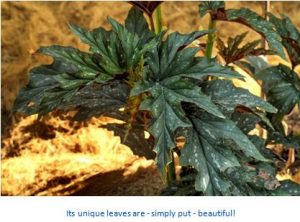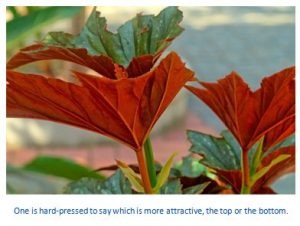By Tommy Clarkson from the July 2017 Edition
Begonia Deliciosa Begonia deliciosa
Family: Begoniaceae
Also known as: No other names, common or botanical
(Why do I seem to have this perverse proclivity to find, admire, acquire and then endeavor to grow plants – like this one – about which there is scant, published information? But, great and grand glutton for punishment that I seem to be, I have striven to persevere. And, following no little rummaging through numerous botanical tomes, publications and articles, coupled with recollection of personal experiences with my specimen, have been able to assemble the following.)
Let’s start out in a somewhat broad scheme, regarding the family-whole, and work to more specifics regarding this particularly attractive species.
The Begonia deliciosa comes from a very large genus, which is comprised of almost 1,000 different species. Most of these plants are endowed with asymmetrica and quite showy leaves that complement large clusters of often, long-lasting flowers. Those blossoms are unisexual meaning that there are both male and female on the same plant.
 Generally speaking, Begonias are honest to goodness edible! Now this fact may have an exciting culinary allure for some and be outright appalling to others. But, by way of re-enforcement of fact, I have read that, during World War IIwhat with the food deprivation resulting from U-Boat attacks on supplies crossing the Atlantic Ocean numerous Britons were forced to eat their Begonia houseplants.
Generally speaking, Begonias are honest to goodness edible! Now this fact may have an exciting culinary allure for some and be outright appalling to others. But, by way of re-enforcement of fact, I have read that, during World War IIwhat with the food deprivation resulting from U-Boat attacks on supplies crossing the Atlantic Ocean numerous Britons were forced to eat their Begonia houseplants.
Beyond these “food by necessity experiences”, I recently read an article which stated that this particular begonia was reputedly being grown, today, as food in Asia!
(So, relative to this consumption of begonias as a mealtime ex- perience . . . . .) In that I strive to not write about anything unless I have personally experienced it or have confirmed it manifold times through professional authorities that I trust im- plicitly, I decided to take this task, personally, to hand. (Or, I guess, that should, more correctly, read “to tongue”.)
Accordingly – actually twice now – I have munched upon a leaf clipped from my Begonia deliciosa. (Suffice it to say, it did not share my enthusiasm in the experience!) With epicurean aims fully intending to be totally addressed, I vigorously chomped into said leaves only to find the taste quite bitter and wholly unsatisfactory to my palate.
So, that fact stated, let’s directly address this poor plant upon which I strove to dine. It was discovered by Jean Linden in 1881, amid the steamy climes of Borneo.
As small plants go, it’s really a rather charming specimen, what with its cleft dark leaves generously spotted with silver. Add to that, its delicate, fragrant, light pink flowers that bloom, usually, around springtime. Horticulturally, it is classified as “rhizomatous, rhizome erect, jointed at or below soil level”.
with silver. Add to that, its delicate, fragrant, light pink flowers that bloom, usually, around springtime. Horticulturally, it is classified as “rhizomatous, rhizome erect, jointed at or below soil level”.
From its odd bulbous growths, at soil level, shoot up stems, reaching skyward. Given the right conditions, it can grow to be a medium-sized shrub.
In less tropical areas it will require winter protection and additional humidity will help. Accordingly, place it near a water source, don’t let the soil dry out, and do all you can to keep the humidity high.
Begonia deliciosa is often compared to the somewhat similar species B. diadema – also “common nameless’ – but, probably, easier to grow. The botanical equivalent of Master and Johnson have meddled, tampered and fussed with its sex life. As a re- sult, it is now a parent of numerous hybrids. (If you’d like to know more specific details check the American Begonia Society site.)
Should you find that you like your Begonia deliciosa, or related plant, there are a few ways to get new plants:
Leaf cuttings Cut off a leaf and leave it in a jar of water until small roots appear, then plant; or, with a razor or sharp knife, cut out a one and a quarter inch (3.18 cm) circle of leaf around the stem. Place the stem and approximately one-third of the leaf in coarse seed-raising mix or perlite/vermiculite.
Wedge cuttings Using a sharp implement, cut the leaf along either side of the main vein before and placing the bottom third of the leaf wedge in one of the previously identified sprouting media.
Root cuttings Cut a small piece of tuber with each stem cut- ting to increase the chances of it successfully rooting.
By seeds With a very great deal of careful attention they can be surface-sown on a moist, but free-draining, seedling me- dium. This is rather challenging as these seeds are exceedingly tiny. (Imagine minute, miniscule dust motes?)
Or, simply go buy one!
Download the full edition or view it online
—
Tommy Clarkson is a bit of a renaissance man. He’s lived and worked in locales as disparate as the 1.2 square mile island of Kwajalein to war-torn Iraq, from aboard he and Patty’s boat berthed out of Sea Bright, NJ to Thailand, Germany, Hawaii and Viet Nam; He’s taught classes and courses on creative writing and mass communications from the elementary grades to graduate level; He’s spoken to a wide array of meetings, conferences and assemblages on topics as varied as Buddhism, strategic marketing and tropical plants; In the latter category he and Patty’s recently book, “The Civilized Jungle” – written for the lay gardener – has been heralded as “the best tropical plant book in the last ten years”; And, according to Trip Advisor, their spectacular tropical creation – Ola Brisa Gardens – is the “Number One Tour destination in Manzanillo”.



